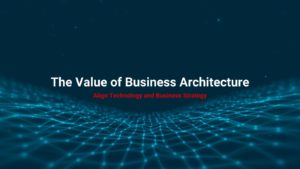Over the last few decades, most large and successful 20th century businesses have calcified around their legacy systems and processes. The journey to becoming more agile and nimble will require a thoughtful, well-structured, well-designed and well-executed multi-year plan. The plan needs to be focused on achieving three major outcomes – Business, Architectural and Organizational. All three matter and need to be properly paced and funded over a 3-5-year timeframe.
Don’t Build From Scratch, Renovate and Modernize
In many of these big, complex industry incumbent companies, it has taken 30-40 years to build the processes and systems that have helped create and manage scale. As modern CIOs, we know we have to transform and create something different. What got us here won’t get us there – to our future vision of being an agile business. However, we can’t just leave what we’ve built behind or cast it aside in favor of building something more modern. Think of what we’ve built so far as our city that we live in. We have to keep living in our city while we renovate or modernize it. It must keep operating, even as we change it.
Explain the Investment in Business Terms
Another way to think about this legacy renewal, as a part of our modernization and transformation plan, is to consider other renewal investments that are common to our industry. For example, this IT renewal and transformation is similar to renewal investments in plant and equipment for Manufacturing, fleet for Travel and Transportation and branches or stores for Retail and Banking. Like the IT transformation from legacy to agile, all of these modernization investments take time and require a well-thought-out plan. The comparison can be helpful in the dialogue with the business leaders we work with. Those leaders might not be comfortable with, or understand, the nuances and specifics of IT, but they will understand renewal and transformation investments on their terms.
Agree on a Holistic, Integrated, Multi-Year Plan
As CIOs, we are always managing a large set of projects and change initiatives in any given year’s annual plan as agreed to in our last budgeting cycle. Also, in many cases, we’ve launched change initiatives at various times to pursue new capabilities that we believe are each important in and of themselves, such as agile development, cloud computing and outsourced managed services. These annual plans and change initiatives are all part of the reality we face every day, but this isn’t enough to guide us toward our real goal of becoming an agile business. We need an integrated, holistic strategy and a multi-year plan. A transformation out of the legacy systems environment and into the modern, agile, digital era requires a well-conceived integrated strategy and a planning horizon of at least 3-5 years. If we take a holistic perspective, take a longer-term view and are conscious about setting our agenda for transformation, this kind of strategy is relatively easy to frame using a fairly common approach. Our strategy will need to include the following:
- A clear, detailed understanding of our current systems, the skills of our IT workforce, economics of IT and how IT impacts business
- A compelling and common Future Vision of what “victory” would look like with all three outcomes in 3-5 years
- A well-paced, executable and affordable multi-year journey (without business systems disruption)
The Phases of the Transformation Journey
This journey needs to include building new capabilities that the business requires and, at the same time, reducing technical debt and complexity. Achieving these outcomes will also require transitioning into a modern technical platform and a major focus on rebuilding the workforce talent base. Building this strategy is the first phase, Phase 1 (Strategy), of the journey. Once we have an agreed upon strategy, getting the phases and the pacing of this journey right is critical to success.
Beyond Phase 1 (Strategy) of the journey, we have found success using the following to describe, plan and execute the next phases.
Phase 2 (Making the Turn)
Usually, the physics of current course and speed project demands are more than an IT organization can realistically achieve. However, we must begin to make a turn in year one towards our future destination. This turn is represented in a small “beachhead” (like the military term that is a first landing spot, part of a much larger and longer campaign, concentrates forces on a small, winnable area and becomes a stronghold for further gains). This “beachhead” should create the first of the new business capabilities and also enables us to build out some of our modern technical foundations and new operating model.
Phase 3 (Up & Running)
In this next phase, we reduce current course projects and increase the pipeline for doing most new things the new way.
Phase 4 (Acceleration or Hitting Stride)
Later, when the new way has become THE way, we can accelerate the transformation. At this point, we are able to mostly self-fund the transformation as our productivity, workforce skills and reduction of technical debt all begin to kick in and show results.
Although we will still have several years left in our journey, we will have overcome the physics of the past and should have a tailwind for continuous evolution. From that point forward, the new modern way is sustainable, and we will have transformed a rigid, slow, complex and expensive legacy business into a modern, agile business built for the digital era.
Author: Charlie Feld, Founder, The Feld Group Institute
Connect with Charlie Feld on LinkedIn ![]()




